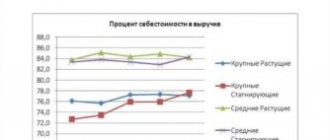What is contribution margin?
Marginal profit (or contribution margin) is the difference between sales revenue and variable costs. Moreover, both of these indicators - revenue and costs - are taken for a specific volume of production.
We can also say that this is the income that remains with the business from sales minus variable costs.
As can be seen from the figure, marginal profit is less than revenue by the amount of variable costs, but more than profit from sales by the amount of fixed costs.
To correctly calculate marginal profit, you need to understand which company expenses are considered fixed costs and which are variable.
Entrepreneur Vasily Petkin decided to start a business producing entrance and interior doors. For him, variable costs will be, for example, expenses for materials, fittings, components, as well as workers’ salaries.
These costs are directly proportional to the number of doors produced, and the more orders there are, the greater these costs. But the costs of maintaining an office and a retail outlet do not depend on how many doors are sold, 10 or 1000 - these are fixed costs. Vasily will bear such expenses even if he does not have a single order.
Thus, fixed costs do not depend on production volumes, and variable costs change in proportion to the amount of products or services produced.
Click to learn more about management accounting outsourcing services
Marginal profit is the part of the revenue that remains with the company to cover fixed costs and make a profit. Therefore, the contribution margin is often called the “covering contribution.”
Marginal profit and accounting profit are two different things. Firstly, they are calculated using different formulas. Secondly, accounting profit is determined for the enterprise as a whole for a period of time, and marginal profit is determined only based on the specific volume of products (work, services) produced and sold.
What is margin?
This term came from Europe. Translated from English Margin or French Marge, margin means markup. Margin is found in banking and insurance business, commercial transactions and securities transactions, etc. Economists call margin the difference between a company's income and the cost of production. Often the words “margin” are replaced with “gross profit”. The principle of calculating the margin is simple: the cost is subtracted from the amount received. The resulting value indicates how much real money the organization receives from the sale of products without taking into account additional costs.
The importance of margin should not be underestimated. It shows how effective a particular business is. Margin is directly related to the company's income and evaluates its activities.
Bank employees talk about margin when they compare the difference in interest rates on loans and deposits. Relatively speaking, if a bank wants to attract customers with high rates on deposits, then it is forced to offer high rates on loans.
Margin plays a big role in assessing the performance of a company. Net profit will directly depend on its size. Margin is the basis for the formation of development funds. The margin percentage (or markup percentage) will be calculated by the ratio of cost to revenue. If you calculate the gross “dirty” profit to revenue, you will get an important indicator - the margin ratio. The percentage will give you the return on sales, and this is the main indicator of the performance of any organization.
How is contribution margin calculated: formula
The value of the indicator we are studying is expressed in absolute and relative values.
The absolute value can be calculated as for the entire production volume:
and for one:
In these formulas, revenue and price are taken without VAT and excise taxes. Unit variable costs are variable costs per unit of output.
Vasily Petkin’s enterprise produced and sold 15 doors at a price of 10 USD. (excluding VAT) each. Variable expenses amounted to 6 cu. per door. The calculation of marginal profit will look like this:
Total marginal profit: 15*10 – 15*6 = 60 c.u.
Marginal profit per unit of production: 10 – 6 = 4 c.u.
More details
Definition and formula
Marginal profitability is calculated as a fraction, the numerator of which is marginal profit, and the denominator is direct (variable) costs.
Article navigation
- What is marginal profitability
- What is the difference between margin and profitability?
- Formula for calculating marginal profitability
The key criterion for the success of any commercial activity is its profitability. Any business entity strives for profit, and therefore indicators are needed that characterize it in an objective digital form. Many entrepreneurs, especially beginners and those without an economic education, confuse the concepts of profit and margin, and instead of these terms they sometimes use the slang word “gain”.
Why do you need marginal profit?
First of all, it is needed to calculate the break-even point. This is the volume of production at which the enterprise covers all its expenses, but does not yet make a profit:
At the break-even point, revenue is equal to the sum of variable and fixed costs, and profit is zero.
Vasily Petkin’s fixed expenses in our example are 400 USD. To find out whether it is enough for Vasily to sell 15 doors to reach the break-even level, let’s calculate the break-even point:
Break-even point (in units): 400 / 4 = 100 doors Break-even point (in monetary terms): (150 * 400) / 60 = 1,000 USD
Thus, Vasily’s enterprise is beyond the threshold of profitability, and revenue does not yet cover all expenses. To break even, he needs to sell 90 more doors. After this, each subsequent door will generate profit.
Such calculations are especially important to make at the stage of a company entering the market, as well as for planning income and expenses.
When a company has several types of products, it is incorrect to compare the absolute amounts of marginal profit, because prices and sales volumes are different.
In this case, the marginal profit ratio is used. It shows how contribution margin relates to sales volume.
The difference between margin and markup
After studying the presented material, a mistaken opinion might have formed about the identity of the concepts “margin” and “markup”. Of course, these terms have many similarities, but they also have significant differences. Thus, margin is an indicator of income after deducting mandatory costs. And the markup represents the additional price of the product.
They also differ in calculation methods. Thus, the calculation of margin depends on the total profit of the company. And the calculation of the markup value depends on the original cost of the product.
Margin and markup are calculated using different formulas. To begin with, here is the formula for calculating margin:
Margin = (Selling price - Cost) / Selling price x 100
In turn, the markup formula is as follows:
Markup = (Sale price - Cost) / Cost x 100
Thus, they differ only in the denominator. Moreover, if you calculate the markup and margin in absolute terms, they will have the same meaning. They will differ only in relative indicators. In this case, the markup will exceed the margin.
Let's give a simple example. Let's say a certain product costs 10 rubles, its cost is 9 rubles. The markup and margin will be 10 - 9 = 1 (ruble). In relative terms, they will differ: the markup will be 1/9=11.11%, the margin will be 1/10=10%
Another difference between margin and markup is that margin can never be 100%. This is explained by the fact that the cost cannot be equal to zero. But maybe a markup.
Margin and markup are needed to track changes in the situation over time. At the same time, the markup and margin are directly proportional to each other: the higher the markup, the greater the margin. From this we can conclude that in order to get more profit, the markup should be raised.
Using markups and margins, you can track how things are changing over time. The higher the markup level, the higher the margin. It follows from this that in order to increase profits and develop the business, you need to increase the markup on the product.
Another concept that should be introduced in this topic is gross margin . It should not be confused with margin and markup. Gross margin is a percentage of total revenue after subtracting direct costs (those associated with producing products and providing services).
Gross margin itself does not in any way characterize the financial condition of a company. An indicator such as the gross margin ratio (GMR) will help us with this. With its help, you can track the dynamics of the company’s economic efficiency, as well as compare this indicator with competitors. The formula is presented as follows:
KVM = VM/VR,
where VM is gross margin;
VR – revenue from product sales.
This indicator is also necessary to calculate the break-even point and the strength of operating leverage.
Formula and example of calculating the marginal profit ratio
The formula looks like this:
The coefficient can be calculated either in shares, using the above formula, or as a percentage. To do this, the resulting value is multiplied by 100.
Calculation of the marginal profit ratio for entrepreneur Vasily Petkin: 4 / 10 = 0.4, or 40%
The contribution margin ratio is also called contribution margin or marginal profitability. It allows you to compare marginal income for different products to manage your assortment.
Vasily Petkin produces 2 types of doors - entrance and interior.
| Product type | Price, USD | Specific variable costs, c.u. | Sales volume, pcs. |
| Interior door | 10 | 6 | 15 |
| Entrance door | 25 | 20 | 20 |
Let's carry out marginal analysis using the above formulas:
| Product type | Interior door | Entrance door |
| Revenue, USD | 150 | 500 |
| Total variable costs, c.u. | 90 | 300 |
| Marginal profit per unit of production, c.u. | 4 | 5 |
| Total marginal profit, c.u. | 60 | 100 |
| Marginal profit ratio | 0,4 | 0,2 |
| Marginal profitability, % | 40% | 20% |
As can be seen from the table, the largest amount of marginal profit is at the entrance doors. It can be assumed that it is more profitable for Vasily to produce them than interior ones. But the marginal profit ratio for entrance doors is half that of interior doors - 20% versus 40%. It turns out that, despite lower revenue and marginal income, interior doors are more profitable. They generate greater returns in relation to sales volume than interiors.
What is it in simple words
Marginality is one of the main concepts in business, stock exchange and banking. It refers to the difference between the cost of production (the cost of manufacturing it) and the price paid by the buyer. It’s not for nothing that the word “margin” in translation means “difference” (margin).
Also, margin often means profit from each unit of production and profitability ratio. The latter helps determine the success of any enterprise.
Video: margin is in simple words:
Therefore, knowledge of the concept of “marginality” is necessary for successful business. After all, even setting a high price for a product does not guarantee high profits. To do this, you must also take into account the costs incurred. That is why it is necessary to be able to correctly calculate the margin. In simple terms, margin is what you received over and above your profit. In other words, this is net revenue.
It is important for a novice businessman to remember products with high margins. They have a high level of demand and are always in demand on the market, since, as a rule, they are represented by only one or several sellers. This allows the manufacturer to receive greater profits from their sale. The following products are considered high-margin:
- seasonal products, usually sold on certain dates;
- branded products.
Examples of goods with a high level of margin are: flowers, non-alcoholic products, hand-made goods, elite alcohol, expensive teas and coffee...
How to interpret the contribution margin ratio
The efficiency of an enterprise depends on how much marginal profit is able to cover fixed costs:
- “minus” marginal profit means that the company has not yet reached the break-even level and has not even covered its variable costs. If the specific marginal profit is negative, it means that gross errors were made in pricing, because the price is below cost and does not even cover unit variable costs. But a positive marginal income does not mean that the business is profitable, because it may not be enough to cover fixed costs;
- if the enterprise has reached the profitability threshold, then marginal profit is equal to fixed costs;
- When a business is efficient, the marginal income is enough to cover fixed expenses and taxes on income, and what is left is the net profit of the business.
You can clearly trace the relationship between sales volumes, marginal income and profit using the example of interior doors by Vasily Petkin (the same source data):
| Door output volume | Revenue | Fixed costs | Variable costs | General costs | Marginal income | Profit from sales |
| 0 | 0 | 400 | 0 | 0 | -400 | -400 |
| 20 | 200 | 400 | 120 | 520 | 80 | -320 |
| 50 | 500 | 400 | 300 | 700 | 200 | -200 |
| 100 | 1000 | 400 | 600 | 1000 | 400 | 0 |
| 150 | 1500 | 400 | 900 | 1300 | 600 | 200 |
| 300 | 3000 | 400 | 1800 | 2200 | 1200 | 800 |
As can be seen from the table, the marginal income becomes positive after selling 20 doors. But production will not be profitable until it reaches the break-even zone (highlighted in blue). For sales of less than 100 doors, the profit from sales is negative, which means a loss. Vasily's business will bring more profit if he sells 101 or more doors. And profitability will increase with increasing sales volume.
This is the result of the “operating leverage effect.” Its meaning is that any change in sales volume leads to an even greater change in the financial result, which is also evident from the table.
What is better to focus on: margin or profit?
These are interdependent indicators. You cannot focus on just one of them. If the preliminary profit value is calculated based on the margin, then the margin size is adjusted based on the profit. Through margin, you can control many components of business processes, such as pricing, which ultimately affects profits. It is impossible to exclude any of these indicators from the financial chain. The outcome could be disastrous. Each company, although it states that the final goal is to make a profit, they might not have achieved it without calculating the potential margin.
Author of the article, financial expert
Dmitry Tachkov
Hello, I am the author of this article. I have a higher education. Specialist in finance and banking. Worked in commercial banks of the Russian Federation for more than 3 years. I have been writing about finance for more than 5 years. Always on topic about the best deposits and cards. I make profitable deposits and receive high cashback on cards. Please rate my article, this will help improve it.
about the author
Useless
5
Interesting
65
Helped
66
Marginal profit rates and ways to increase it
There is no standard for marginal profit. Its level varies greatly depending on the industry and product category. Unlike luxury goods, goods and services with legal price restrictions will always have low margins.
How you can increase your profit margin:
- Increase revenue. Ideally, one should strive to increase the price category of a product by building trust in the brand, increasing its prestige and quality of service. But it is unrealistic to constantly raise prices, so you can take the path of increasing production volumes. This will reduce overall costs and increase the share of profit in the structure of marginal income.
- Reduce variable costs: look for the most favorable conditions for the purchase of raw materials (discounts from dealers or volume of purchases, import substitution, etc.), and also attract cheaper labor.
- Reconsider the assortment: increase the share of goods with the highest margins in total sales. In our example, at Vasily Petkin’s enterprise, the high-margin product is interior doors, so in order to increase the total marginal profit, he needs to increase the production of this particular category of product.
Thus, the management-based analysis discussed above can significantly improve business efficiency.
As part of comprehensive accounting services, 1C-WiseAdvice provides services for preparing data for management accounting and reporting. Such reporting is tailored to the specifics of your business. If you need to make settings from scratch, we have ready-made report templates. We will help you develop requirements for the implementation of management accounting and introduce you to our best practices.
Margin and Gross Profit: What's the Difference?
photo from dela.biz website
Financial indicators that reflect the dynamics of the company's development are quite similar to each other. This causes confusion. At the same time, there is a difference between margin and profit – the key characteristics of assessing a company’s performance.
So, the first of them takes into account only production costs. Their totality is the cost of the product. Profit implies a broader analysis of indicators - when calculating it, the entire set of expenses and income that arose during the production process and during the sale of products is taken into account.
Let's say you have a private company that produces articulated dolls. To make them, you will need consumables (for example, papier-mâché, self-hardening clay), equipment (a set of tools), paints and accessories. All that will be spent on the production of one doll are the characteristics from which the cost of the item will be formed. Let's imagine that the consumables cost you $20. When forming the selling price of the finished product, you take into account the operation of the tools (and when using special equipment, for example, an oven for fixing the mold, the depreciation costs of the devices), the time you spent on developing the project and its implementation. In addition, you will probably remember to evaluate the artistic value of your work, adding some subjective criteria to the cost based on factual data. As a result, you will get a figure that exceeds $20 several times - for example, $200.
Essentially, the difference between the selling price and your actual expenses is the profit you earned. However, this is not quite true. From the point of view of terminology, such a concept as “profit” takes into account not two indicators, but much more.
If we return to the example with a doll, then when calculating real income you will, conditionally, have to take into account the amount of tea that you drank when sculpting and designing the product, payment for the Internet involved in advertising the product, transportation costs associated with sending the goods in the case of an addressee located in another city, etc. Only after taking into account all the data can you draw a conclusion as to how much you were able to earn. This is the difference between profit and margin.
Analysis of the company's activities shows that these two indicators are always directly proportional. The greater one is, the higher the value of the other in a particular reporting period. At the same time, the margin, for obvious reasons, is always higher than profit.
What is the difference between margin, revenue and profit?
- It is worth noting that profit, margin and income indicate the success of a business, but in slightly different areas. The main difference between margin and profit from income is the presence of accounting for any expenses. Yes, negative indicators can add up. But income will never talk about utility or salary expenses. That is , he always speaks for the overall monetary benefit.
- Margin shows the profitability and profitability of products due to percentage markup. After all, the larger it is, the more profit will be received. Margin is a kind of hint for proper business development.
- But profit is the final, final value of the funds that the entrepreneur will receive after all due payments. That is, that he will actually earn money without costs or investments. It is this indicator that indicates how successful the business has been.
But there is also something in common - all three components speak for a monetary rise
- But it can be seen that profit is the accounting of all expenses and income of the company. In turn, when calculating the margin, we take only variable production costs.
- In economist circles, the concept of “operating leverage effect” is widespread. This is when a change in margin corresponds to a change in profit. And the increase and decrease in profit in percentage terms is almost always less than the change in margin. Remember that profit is a component of margin, so it cannot be greater than it!
To summarize, it is worth saying that margin, income or profit are concepts that play a key role in assessing the performance of a company. Or rather, in calculating its expenses and income. This is important when analyzing the efficiency of resource use and the overall performance of the enterprise.










